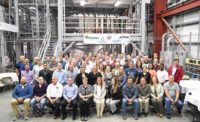
The last and largest of nine defunct nuclear reactors once used for weapons production at the U.S. Energy Dept.'s huge Hanford site in Washington state has been placed in safe storage, or "cocooned," so its remaining high radioactivity can safely decay, the agency said on June 14.
The new status for the site's N Reactor follows a $65-million cleanup and demolition project, which included demolishing the 85,450-sq-ft building to its shield walls.
The building also included three below-grade, 47-ft-deep floor areas and four above-grade floors, up to 80 ft high. Crews removed all equipment and stabilized loose contamination. They placed a roof on the structure, installed temperature and moisture sensors for remote monitoring, and sealed all openings.
The reactor, which produced both plutonium for weapons and steam for residential power during operations from 1963 to 1987, was three times larger than others on-site.
"It had twice the magnitude of asbestos and hazardous materials to remove due to the size of the reactor and heat exchange buildings," says Ruben Trevino, project manager for Washington Closure Hanford, the joint venture of URS, Bechtel and CH2M Hill that managed cleanup.
"It was also the closest of the reactors to the Columbia River. Demolition took more precision and time." Washington Closure says it is now "on track" to complete full cleanup of Hanford's River Corridor section by 2015.



Post a comment to this article
Report Abusive Comment